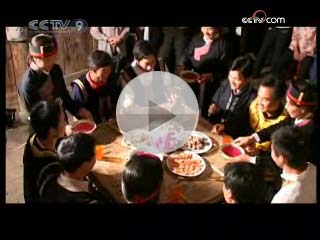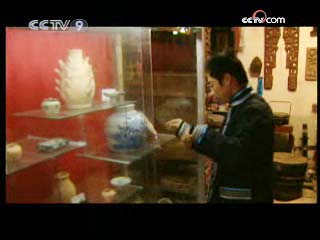------Program code: DO-080824-02010 (what's this?)
Source: CCTV.com
08-24-2008 08:27
There’s a small village called Banyueli in Xiapu County, Ningde City in Fujian Province. It’s home to 70 families, all belonging to the She ethnic group and mostly sharing the same family name, Lei. This small village surrounded by mountains has a history of 300 years.
 |
It has three old houses and many historical relics dating from the Ming and Qing dynasties. These days, most of the young people have left the village, to go and work in the cities. One of the few young people to remain is Lei Huaxiang. For a time she was thinking about working away from home. But then she met a young man named Qisong and decided to stay. Lei Huaxiang loves to sing She folk songs. Her romance with Qisong began with some antiphonal singing.
 |
The tea plucking songs are popularly sung by the She people while they are at work. A song is improvised by the young men and women when they fall in love. In She areas, it’s through this form of antiphonal singing that romances are born.
Its rich cultural heritage and long history have made Banyueli Village famous. Two years ago, Qisong and his uncle opened a village museum, housing cultural relics belonging to his family and others in the village. Qisong now devotes all his time to the museum, and has even abandoned his plan to head for the city in search of work.
On display in the museum are 370 treasures. Among them there are 170 pieces of celadon, 50 gift boxes and dressers, and more than 100 copes of She folk songs. The collection has attracted interest from a number of experts and scholars.
The engagement ceremony is to be held this morning at Lei Huaxiang’s home. She is the eldest child in her family. Her sister and brother have both left home to find work. Only she has stayed to help her mother plant and pick the tea.
Two traits that have always been highly valued in Banyueli are solidarity and harmony. Conflicts are unknown in the village, and no one ever locks their doors at night. If a family is in difficulties, everyone will lend a helping hand. By noon, people are crowding Huaxiang’s home.
Making sticky rice cakes is a tradition among the She ethnic group, especially at festivals. The sticky rice is first steamed after being soaked in water for a while, and then the rice is put in a stone container, where it is beaten repeatedly using a stone pestle. After that the dough-like sticky rice is placed in a dustpan filled with flour. After being kneaded and having sesame powder added, it is ready. Eating sticky rice cakes is an important part of any engagement ceremony, when the parents of the young couple announce the engagement to all the villagers, and inform them of the date of the wedding.
In a traditional She wedding, the bride’s dress is very complex. She usually wears a Phoenix dress, which can take up to two months to complete. Huaxiang’s mother has decided to inform the tailor, Lei Xiangquan, early.
Lei Xiangquan is the only tailor in the village who can make a Phoenix dress. His family has been making Phoenix dresses for three generations. It’s difficult to imagine how the delicate patterns could be produced by a man’s hands. A Phoenix dress is patterned with a phoenix and peony design. Unlike the custom in other ethnic groups, which is for the dowry to be made by the women, She women do not do needlework.
Before a She girl gets married, many traditions need to be observed. Some of them go by such names as “being the cousin”, “marry-daughter wine” and “bride welcoming mother-in-law”. “Being the cousin” involves the bride bride-to-be, some time before the wedding, being invited by her aunts to sing for some guests. All the male singers in the village can accompany her. If there is no one in the village who can sing well enough, men can be brought in from other villages. However, in other She communities, this tradition may no longer be observed.
